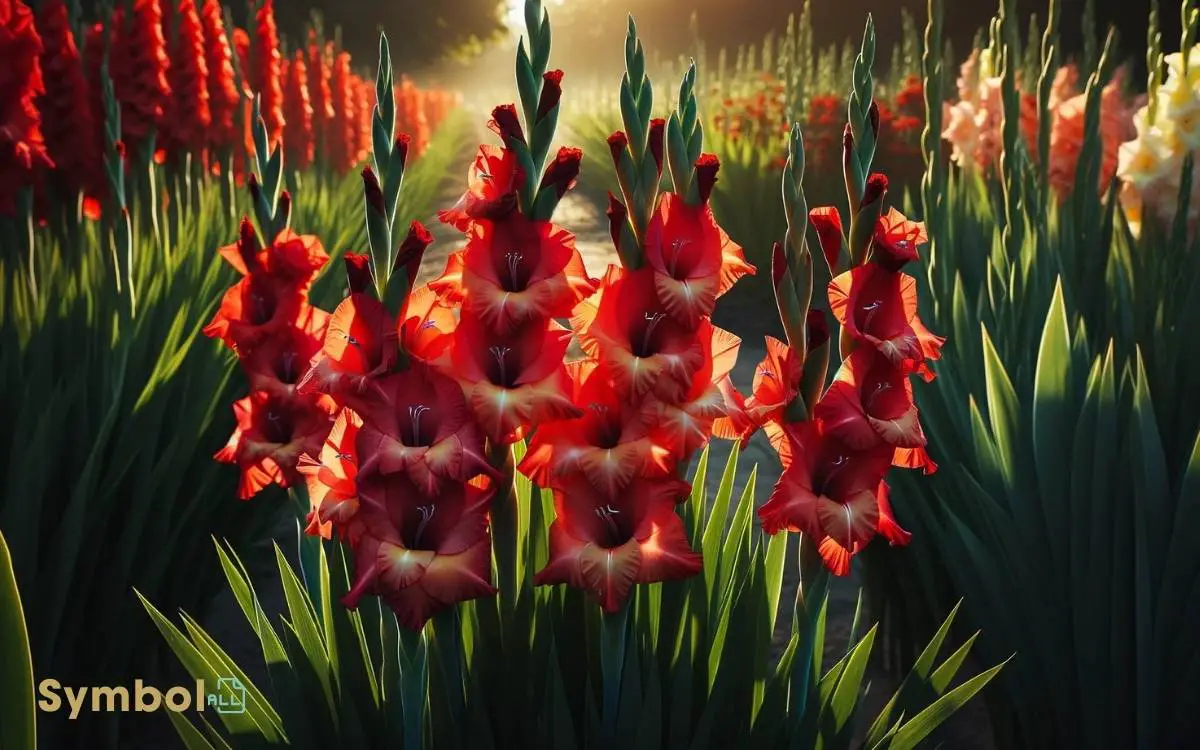What Does the Gladiolus Flower Symbolize? Strength!
The Gladiolus flower, part of the Iridaceae family from Africa since the late 17th century, holds deep symbolism.
You’re looking at a plant distinguished by sword-shaped leaves, reflecting its name’s Latin origin, ‘gladius’ meaning sword. It’s found mainly in sub-Saharan Africa, thriving in various climates.
Historically, it symbolized strength and moral integrity, traits revered by Roman gladiators and embedded in ancient Mediterranean myths. Each color variation of the Gladiolus conveys specific sentiments, from love and passion to joy and friendship.
Unraveling its hues and forms, you’ll discover a rich tapestry of meanings that span across cultures and epochs, revealing a complex world of symbolism.

Key Takeaways
History of the Gladiolus
The gladiolus, belonging to the Iridaceae family, has a rich history that traces back to Africa in the late 17th century, where it was first cataloged by European botanists.
This genus, comprising approximately 260 species, is distinguished by its striking, sword-shaped leaves, a characteristic that also influenced its name – derived from the Latin ‘gladius’, meaning sword.
You’ll find these perennials primarily in sub-Saharan Africa, with a significant presence in South Africa, extending into the Mediterranean and Middle East. Their adaptive nature allowed them to thrive in various climates, leading to widespread cultivation.
Symbolism in Ancient Times
In ancient Rome, the Gladiolus, belonging to the Iridaceae family, served as a floral emblem for gladiators, symbolizing strength and moral integrity.
This genus, characterized by sword-shaped leaves, was intertwined with ancient Mediterranean myths, reflecting its significance beyond mere ornamental use.
You’ll find that these associations provide a deep insight into how cultures revered the Gladiolus for its virtues and symbolic meanings.
Roman Gladiators Floral Emblem
Why did Roman gladiators adopt the gladiolus as their emblem, you might wonder? The answer lies deeply rooted in the flower’s characteristics and the cultural context of the era.
Gladiolus, deriving its name from the Latin word “gladius,” meaning sword, resonates with the gladiators’ world, where strength and valor were paramount.
| Feature | Scientific Detail | Symbolism in Ancient Rome |
|---|---|---|
| Name Origin | Gladiolus from Latin gladius | Sword-like significance |
| Form | Linear, sword-shaped leaves | Strength and prowess |
| Cultural Role | Used in ceremonial events | Emblem of honor and respect |
This table encapsulates the essence of why gladiolus held such symbolic weight among Roman gladiators, embodying their ideals without delving into aspects of moral integrity or strength beyond the physical resemblance and cultural significance.
Strength and Moral Integrity
Exploring the symbolism of the gladiolus beyond its physical attributes reveals its association with not only strength but also moral integrity in ancient cultures.
Belonging to the Iridaceae family, Gladiolus spp., with its sword-shaped leaves, naturally evokes the imagery of strength. This botanical characteristic led ancient civilizations to regard the gladiolus as a symbol of moral integrity, embodying virtues such as sincerity and honor.
The flower’s vibrant blooms and robust stature further underscored these qualities, making it a revered symbol in societal rituals and ceremonies.
Its role in ancient societies wasn’t merely decorative; the gladiolus served as a living confirmation to the enduring values of strength and moral fortitude, deeply ingrained within the cultural fabric of the time.
Ancient Mediterranean Myths
Delving into ancient Mediterranean myths uncovers the gladiolus flower’s deep-rooted symbolism, reflecting its significance in rituals and beliefs of those times.
| Aspect | Significance |
|---|---|
| Flower Structure | The linear arrangement of the gladiolus blooms on the spike, known scientifically as an inflorescence, symbolized the ladder to the gods, bridging the earthly and the divine. |
| Color Variations | Each hue of the gladiolus, ranging from vibrant reds to gentle purples, held distinct meanings. For instance, red symbolized strength and valor, while purple was associated with the nobility of spirit. |
| Seasonal Blooming | Its blooming in late summer was seen as a sign of the gods’ favor, marking a time of harvest and abundance. |
| Cultural Integration | Beyond its physical attributes, the gladiolus was integrated into various ceremonies and myths, representing fertility, moral integrity, and the cycle of life and death. |
This historical context enriches our understanding of the gladiolus’s enduring appeal.
Strength and Integrity
You’ll find that the Gladiolus genus, within the Iridaceae family, encapsulates more than its striking aesthetics; it embodies the core virtues of strength and integrity.
These traits aren’t merely abstract concepts but rooted in the plant’s biological resilience and structural integrity, from its robust flowering spikes to its sword-shaped leaves.
In exploring the symbolic meanings, you’re engaging with a tradition that spans cultures and centuries, highlighting how these virtues are universally revered.
Core Virtues Highlighted
The gladiolus flower symbolizes strength and integrity, embodying these core virtues through its robust and upright growth pattern.
Here’s how these qualities are reflected in its botanical characteristics and growth habits:
- Robust Stems: Gladiolus plants, belonging to the Iridaceae family, feature strong, sword-shaped leaves, supporting their vertical growth and resilience against external pressures.
- Linear Growth: Their linear, upright growth pattern demonstrates the virtue of integrity, growing steadfastly and true to form.
- Prolific Blooming: The numerous flowers that bloom along the stem signify the strength in numbers and the unity of purpose.
- Adaptive Nature: Adaptability to a variety of soil conditions and climates highlights the plant’s inherent strength and determination to thrive.
These elements illustrate how the gladiolus mirrors the virtues of strength and integrity in the natural world.
Symbolic Meanings Explored
Exploring the symbolic meanings of the gladiolus, we find that its representation of strength and integrity is deeply rooted in both its botanical characteristics and enduring cultural significance.
The Gladiolus genus, belonging to the Iridaceae family, comprises species that exhibit robust growth and resilience. These perennial plants, characterized by tall, striking spikes and vibrant, sword-shaped leaves, mirror virtues of fortitude and moral uprightness.
The term ‘gladiolus’ itself derives from the Latin ‘gladius,’ meaning sword, underscoring the flower’s association with Roman gladiators and the virtues of strength and integrity they epitomized.
This correlation not only reflects the physical attributes of the gladiolus but also imbues it with a symbolic legacy celebrating resilience and steadfastness in the face of life’s challenges.
Representations of Love
Gladiolus flowers embody deep expressions of love through their vibrant blooms and intricate petal arrangements, symbolizing strength, integrity, and infatuation within romantic contexts.
In the domain of botany, Gladiolus, belonging to the Iridaceae family, showcases a wide array of colors, each representing different nuances of affection and admiration.
- Vibrant red tones signify passionate love, embodying the fiery depth of romantic emotions.
- Soft pink shades convey gentleness, symbolizing an admiration that whispers tender affection.
- Rich purple hues illustrate admiration and grace, often associated with the majesty of love’s elegance.
- Pure white variations stand for purity and innocence, reflecting a love that’s sincere and true.
Understanding these colors allows you to select Gladiolus flowers that perfectly match your emotional intentions, making them a profound way to communicate feelings of love.
Gladiolus in Mythology
Beyond their symbolic expressions of love, gladioli hold a rich tapestry of tales within mythology, shedding light on their significance in ancient cultures.
| Culture | Myth | Significance |
|---|---|---|
| Greek | Thrown by the gods as swords that flowered upon landing. | Represents strength and integrity. |
| African | Belief in gladiolus guiding the dead to the afterlife. | Symbolizes eternal sleep and remembrance. |
| European | Associated with gladiators, who wore them for protection. | Embodies victory and moral integrity. |
| Roman | Given to gladiators who triumphed in battle. | Stands for victory, honor, and commemoration. |
These stories, deeply rooted in the taxonomy of *Gladiolus spp.*, illustrate how this genus has been emblematic of both beauty and strength across various cultures.
Their enduring legacy in mythology continues to captivate those seeking to understand the deeper meanings behind these striking flowers.
Cultural Significance Worldwide
Delving into the cultural significance of *Gladiolus spp.* across the globe, you’ll uncover how these flowers have woven their way into the fabric of various societies, symbolizing a range of virtues from strength to moral integrity.
Prominent aspects include:
- In South Africa, wild Gladiolus species exemplify the country’s rich biodiversity, standing as a symbol of natural beauty and resilience.
- Ancient Roman gladiators were often associated with Gladiolus representing strength and victory in the face of adversity.
- In China, these blooms are gifted as tokens of moral integrity and remembrance, highlighting their role in social customs.
- European folklore often celebrates Gladiolus for its protective properties, believed to ward off evil.
This diversity in symbolism underlines the universal appeal of *Gladiolus spp.*, transcending cultural barriers.
Colors and Their Meanings
In the vibrant world of *Gladiolus spp.*, each color variation carries a unique symbolism, ranging from passion to purity, deeply rooted in their botanical characteristics and historical associations.
Red gladioli, for instance, symbolize love and passion, reflecting their intense coloration that mirrors the human heart’s fervor.
White variants stand for purity and innocence, their pristine blossoms offering a stark contrast to the red’s ardor, signifying unblemished love or a fresh start.
Yellow gladioli, with their bright, cheerful petals, convey joy and friendship, often used to uplift spirits.
Purple gladioli, on the other hand, denote grace and elegance, their royal hue associated with nobility and dignity in floral language.
Each hue of *Gladiolus spp.* communicates specific sentiments, making them a versatile choice for expressing complex human emotions.
Gladiolus in Art and Literature
Exploring the domains of art and literature, the Gladiolus spp. has been a recurrent symbol, reflecting its diverse meanings from passion to purity through various creative expressions.
This genus, belonging to the Iridaceae family, has been intricately woven into the fabric of human expression, showcasing its significance across cultures and epochs.
- In Renaissance paintings, Gladiolus spp. represented the Roman gladiators, symbolizing strength and moral integrity.
- Victorian literature used these flowers to convey hidden messages of love or challenge, depending on the context and color.
- Gladiolus motifs in poetry often symbolize remembrance, enhancing narratives with a layer of emotional depth.
- Botanical illustrations from the 18th century meticulously document the plant’s taxonomy, contributing to both scientific knowledge and aesthetic appreciation.
This multifaceted representation underscores the Gladiolus spp.’s enduring allure in artistic and literary domains.
Modern Symbolic Uses
Moving into the contemporary era, gladiolus flowers continue to embody a spectrum of symbols, from strength and victory to expressions of remembrance.
Belonging to the *Gladiolus* genus within the Iridaceae family, these perennials are characterized by their sword-like leaves and vibrant blooms.
Each color variation further nuances its symbolic meaning. For instance, red gladioli convey deep love and passion, while white varieties symbolize purity and innocence.
With over 260 species, the adaptability and diversity of gladiolus flowers allow them to serve as poignant symbols across various contexts.
Their role in modern memorials, for instance, underscores their capacity to evoke powerful emotional responses, serving as a bridge between the past and present in commemorating significant individuals or events.
Gladiolus in Celebrations
Reflecting their versatile symbolism, gladioli are often featured in various celebrations, where their vivid blooms add depth and meaning to the festivities.
These flowers, belonging to the genus Gladiolus, play a notable role in:
- Weddings: Symbolizing strength and integrity, they’re a popular choice for bouquets and decorations, celebrating the new journey of the couple.
- Funerals: Representing moral integrity and remembrance, gladioli are used to honor the deceased’s character and life.
- Birthdays: Their bright colors and towering presence make them ideal gifts, symbolizing the celebration of life and growth.
- Cultural Festivals: In some cultures, gladioli are part of annual festivities, symbolizing faith, honor, and memory, reflecting the community’s values and traditions.
In each context, the gladiolus’s taxonomic attributes, specifically their diverse color range and striking form, contribute significantly to their symbolic importance.
Growing and Caring Tips
For the thriving blooms and optimal growth of your Gladiolus plants, it’s essential to plant them in well-drained soil with full sun exposure, following their specific requirements within the Iridaceae family.
These perennial corms, falling under the order Asparagales, flourish in environments where they can receive at least six hours of sunlight daily. To guarantee robust development, incorporate a balanced, slow-release fertilizer into the soil at planting time.
Watering should be consistent, allowing the soil to become moderately dry between sessions to prevent corm rot. Staking might be necessary for taller varieties to support their statuesque spikes against wind.
As autumn approaches, in cooler climates, you’ll need to dig up the corms post-frost and store them in a cool, dry place over winter for replanting come spring, ensuring another season of vibrant displays.
Conclusion
You’ve journeyed through the gladiolus garden, grasping its grandeur from ancient allegories to modern meanings.
This striking spear, Gladiolus spp., symbolizes strength, integrity, and infatuation, intertwining its tale from mythic mentions to heartfelt homages in horticulture.
As you cultivate these charismatic companions, remember their robust resolve and romantic radiance. Cherishing the gladiolus goes beyond gardening; it’s about growing a manifestation of genuine goodwill.
Embrace every elegant, elongated bloom, for it’s a proof to timeless tales and tender tokens.






